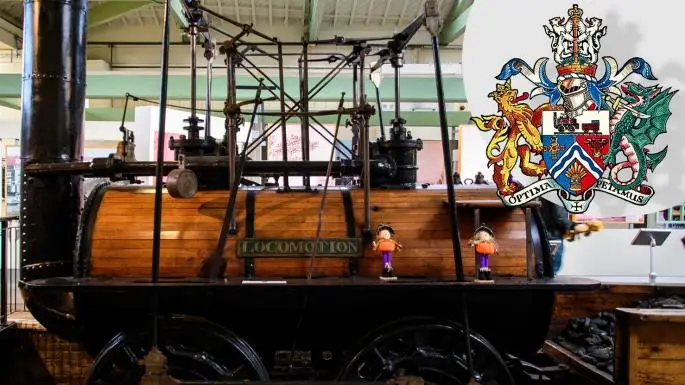Locomotion No 1 on display in Darlington, where it features on the town coat of arms. The threat to relocate it has provoked a fierce response

From The Times 24th January 2020
For 163 years the world’s first passenger steam engine has been “the jewel in the crown” of Darlington’s railway heritage.
Now the town has rounded on the National Railway Museum (NRM), owners of Locomotion No 1, after it revealed plans to uproot the engine and make it the centrepiece of a £4.5 million revamped exhibition in Shildon, near by.
Darlington has accused the Science Museums Group (SMG), of which the NRM is a part, of “cultural vandalism” amid claims that it belongs to them — the engine features on the town’s coat of arms and on Darlington FC’s shirt badge. Locomotion No 1 has been owned by SMG since 1968 and is on loan to Darlington until March 2021.
The town has launched a campaign to keep the artefact, with rail enthusiasts and cross-party politicians joining the fray. They say that with the 200th anniversary of the
in 2025 and plans for a new rail heritage quarter in Darlington, the loss would be a “major blow”.
Heather Scott, leader of Darlington council, said: “This is something people will be horrified about. I want to send a very clear message that this council will leave no stone unturned in our quest to keep Locomotion No 1 in Darlington.”
Peter Gibson, the town’s new Tory MP, said he was “outraged at the prospect of our most treasured and most important artefact being removed” and that the whole town would back the campaign for Locomotion No 1 to stay put.
Locally it has been pointed out that Joseph Pease, who paid £50 to restore the engine when it reached the end of its working life more than a century ago, wanted it to be displayed in Darlington. “For the last 163 years each of these organisations has respected Joseph Pease’s intention,” his great-great-great-grandson told the Northern Echo.
The NRM, however, argues that Locomotion No 1 began its journey in Shildon, which is also “the birthplace of the modern passenger railway”. It plans to double the size of its Locomotion museum at Shildon before the bicentenary of the Stockton and Darlington Railway in 2025.
In a statement, the NRM said: “A £4.5 million plan will see the construction of a new, 4,000 sq m Building Two, close to the existing visitor centre which will almost double the amount of covered space available to the public. The building will house up to 40 vehicles from the national collection, bringing the total number of rail vehicles at Locomotion to more than 100.” Construction is due to start in October next year and the building to open in September 2022.
A spokesman said loan agreements were common between museums and that the NRM group had more than 2,000 loans at any one time. Loan periods are typically for three to five years. The loan agreement for Locomotion No 1 was signed in 2016.
Sir Peter Hendy, a trustee from the SMG, said: “As we head towards once-in-a-lifetime railway anniversaries, the development of Building Two and the homecoming of Locomotion No 1 will give the museum even more opportunities to put the heritage of Shildon on the map .”
Locomotion No 1 “retired” from railway service in 1841 and in 1850 was sold to Pease’s West Durham colliery, where it powered a water pump.
By 1856, its working life was finally over and proposals were made for it to be auctioned, but its historical importance was appreciated and it was restored to working order.
It formed part of the 50th Jubilee celebrations of the Stockton and Darlington Railway in 1875 and, after travelling around various expeditions at home and abroad, returned there.
One Response
Can anyone explain this reference ‘The NRM, however, argues that Locomotion No 1 began its journey in Shildon’. I don’t know much about railway history so don’t understand how Shildon fits into the story.
As a former museum curator I would add that 21st century museums should not be restricted by the wishes of a donor or interested party from 163 years ago otherwise they become completely fossilised in what they can or cannot display. Just a thought.